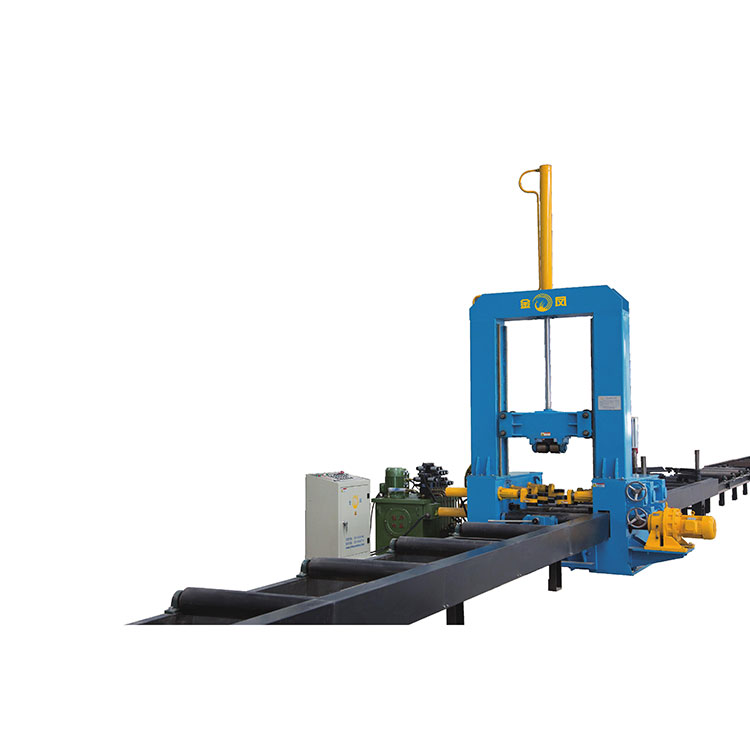 English
English Español
Español  Português
Português  русский
русский  Français
Français  日本語
日本語  Deutsch
Deutsch  tiếng Việt
tiếng Việt  Italiano
Italiano  Nederlands
Nederlands  ภาษาไทย
ภาษาไทย  Polski
Polski  한국어
한국어  Svenska
Svenska  magyar
magyar  Malay
Malay  বাংলা ভাষার
বাংলা ভাষার  Dansk
Dansk  Suomi
Suomi  हिन्दी
हिन्दी  Pilipino
Pilipino  Türkçe
Türkçe  Gaeilge
Gaeilge  العربية
العربية  Indonesia
Indonesia  Norsk
Norsk  تمل
تمل  český
český  ελληνικά
ελληνικά  український
український  Javanese
Javanese  فارسی
فارسی  தமிழ்
தமிழ்  తెలుగు
తెలుగు  नेपाली
नेपाली  Burmese
Burmese  български
български  ລາວ
ລາວ  Latine
Latine  Қазақша
Қазақша  Euskal
Euskal  Azərbaycan
Azərbaycan  Slovenský jazyk
Slovenský jazyk  Македонски
Македонски  Lietuvos
Lietuvos  Eesti Keel
Eesti Keel  Română
Română  Slovenski
Slovenski  मराठी
मराठी  Srpski језик
Srpski језик
How Do Beams Welding Lines Improve Structural Efficiency in Modern Manufacturing?
2025-11-03
In modern industrial production, the precision and efficiency of structural assembly are paramount. Beams Welding Lines represent a transformative technology in the fabrication of steel and metal frameworks. These lines are automated or semi-automated systems designed to weld beams with consistent quality, speed, and structural integrity. By integrating advanced robotics, laser-guided positioning, and intelligent control systems, Beams Welding Lines enhance production throughput while maintaining high standards of safety and durability.
The purpose of this article is to provide an in-depth analysis of Beams Welding Lines, including their core parameters, advantages, operational mechanisms, and future trends. By understanding these systems, manufacturers can optimize their production lines, reduce costs, and achieve superior structural performance.
What Are the Key Features and Technical Parameters of Beams Welding Lines?
Beams Welding Lines are engineered to handle a range of beam sizes and profiles, supporting various welding methods such as MIG, TIG, and submerged arc welding. Their design ensures repeatable precision, reducing human error and enhancing weld quality.
Key Technical Parameters:
| Parameter | Specification/Range |
|---|---|
| Beam Size Capacity | H-Beams: 100mm–600mm; I-Beams: 100mm–500mm |
| Welding Speed | 0.5–2.0 meters per minute (adjustable) |
| Welding Method | MIG, TIG, Submerged Arc |
| Automation Level | Semi-automatic to fully automatic |
| Positioning Accuracy | ±0.5mm |
| Control System | PLC-based with HMI interface |
| Power Supply | 380V/50Hz three-phase |
| Welding Wire Diameter | 1.2mm–2.5mm |
| Maximum Load Capacity | 5 tons per fixture |
| Safety Features | Emergency stop, light curtain, gas detection |
These parameters highlight the adaptability of Beams Welding Lines in handling different structural components while maintaining precision and safety. Their modular design allows integration into existing production lines with minimal disruption.
Why This Matters: Manufacturers benefit from improved consistency, reduced rework, and optimized labor allocation. Automated beam welding lines reduce operator fatigue while maintaining high production output.
How Do Beams Welding Lines Operate and Enhance Efficiency?
Understanding the operational workflow is crucial for evaluating the effectiveness of Beams Welding Lines. The typical process involves:
-
Beam Loading: Beams are automatically positioned using roller conveyors or robotic arms.
-
Precision Alignment: Laser or mechanical guides ensure exact placement for uniform welding.
-
Welding Execution: Robotic arms perform MIG, TIG, or submerged arc welding along pre-programmed paths.
-
Quality Inspection: Inline sensors and cameras detect welding defects, ensuring compliance with structural standards.
-
Finished Beam Unloading: Completed beams are moved to the next production stage or storage.
Advantages of This Operational Approach:
-
Consistency: Every beam is welded to exact specifications.
-
Speed: Automated lines can produce multiple beams simultaneously, increasing throughput.
-
Safety: Reduced manual handling lowers the risk of accidents.
-
Material Efficiency: Accurate welding minimizes waste and reduces operational costs.
-
Scalability: Systems can be expanded or upgraded as production demands increase.
Why Manufacturers Choose Beams Welding Lines: In competitive markets, consistent quality and faster turnaround times are critical. By automating welding, companies can achieve higher production efficiency without sacrificing structural integrity.
Why Are Beams Welding Lines Critical for Future Trends in Construction and Industry?
As industrial demands evolve, Beams Welding Lines are positioned at the intersection of automation, sustainability, and smart manufacturing. Several trends are driving their adoption:
-
Smart Factory Integration: Modern lines are equipped with IoT sensors and cloud connectivity, enabling real-time monitoring and predictive maintenance.
-
Energy Efficiency: Advanced power management and welding control reduce electricity consumption and CO₂ emissions.
-
Customization Capabilities: Flexible programming allows adaptation to different beam sizes, shapes, and structural requirements.
-
High-Precision Construction Needs: Infrastructure projects increasingly require exact tolerances that manual welding cannot consistently deliver.
-
Global Competitive Standards: As international building codes become stricter, automated beam welding ensures compliance with quality standards.
The continuous innovation in robotics, AI-driven welding optimization, and sensor integration suggests that Beams Welding Lines will remain a cornerstone of industrial production, particularly in construction, shipbuilding, and heavy machinery manufacturing.
FAQs About Beams Welding Lines
Q1: What types of beams can be welded using these lines?
A1: Beams Welding Lines can handle a variety of steel profiles, including H-beams, I-beams, and custom structural profiles. The system supports beam widths from 100mm up to 600mm and heights up to 500mm, accommodating both standard and non-standard construction requirements.
Q2: How is weld quality ensured on automated lines?
A2: Quality is maintained through a combination of precise positioning systems, consistent heat input control, and inline inspection mechanisms. Sensors detect deviations in weld seam width, penetration, and surface quality. In addition, robotic arms maintain uniform speed and pressure during welding, minimizing defects and ensuring structural reliability.
Q3: What maintenance is required for Beams Welding Lines?
A3: Regular maintenance includes cleaning welding heads, checking wire feed mechanisms, calibrating positioning systems, and updating control software. Predictive maintenance features in modern lines can alert operators to component wear before failures occur, reducing downtime and repair costs.
Q4: Can these lines be integrated into existing production facilities?
A4: Yes, the modular design of Beams Welding Lines allows seamless integration. Conveyors, robotic arms, and control systems can be adapted to existing floor layouts, minimizing installation disruption while optimizing workflow efficiency.
Investing in Beams Welding Lines for Long-Term Success
In summary, Beams Welding Lines represent a strategic investment for manufacturers aiming to enhance efficiency, quality, and safety. They combine automation, precision, and flexibility to meet the demands of modern industrial production. From technical specifications to operational workflow, these systems streamline beam welding while maintaining high standards of structural integrity.
With the increasing demand for high-precision construction and automated manufacturing solutions, Beams Welding Lines are positioned as an essential asset for future-ready factories. Brands like JINFEN are at the forefront of delivering innovative solutions in this field, offering customizable and high-performance welding lines tailored to specific industrial needs.
For more detailed information on Beams Welding Lines and to explore solutions that fit your production requirements, contact us today to discuss your project and get professional guidance.





